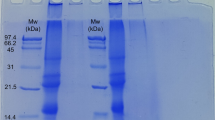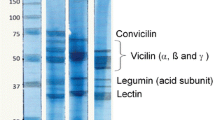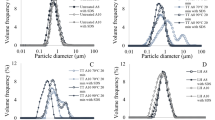Abstract
The effect of bovine serum albumin (BSA), whey protein isolate (WPI), whey protein hydrolysate (WPH), sodium caseinate (SC), carboxymethylcellulose sodium (CMC), fish gelatin (FG), high methoxyl apple pectin (HMAP), low methoxyl apple pectin (LMAP), gum Arabic (GA), ι-carrageenan (CGN), and hydroxypropyl chitosan (HPCTS) on physical stability of internal or external aqueous phase of water-in-oil-in-water (W/O/W) emulsions was evaluated. WPI and CGN in the internal aqueous phase, and GA, HPCTS, and CMC in the external phase reduced the size of emulsion droplets. BSA, WPI, SC, FG, CGN, and HPCTS improved the dilution stability of W/O/W emulsions, but HMAP had a negative effect. BSA, WPI, SC, FG, LMAP, GA, CGN, HPCTS, or CMC significantly improved the thermal stability of W/O/W emulsions. Results also indicated that the addition of CGN (1.0%), HMAP (1.0%), WPH (1.0%), or HPCTS (1.0%) in internal aqueous phase significantly increased the viscosity of emulsions, however, addition to the external aqueous phase had insignificant effects. A protein-knockout experiment confirmed that proteins as biomacromolecules, were the key factor in improving physical stability of emulsions.







Similar content being viewed by others
References
Akhtar N, Yazan Y (2008) Formulation and in vivo evaluation of a cosmetic multiple emulsion containing vitamin C and wheat protein. Pak J Pharm Sci 21(1):45–50
Al Haushey L, Bolzinger MA, Bordes C, Gauvrit JY, Briançon S (2007) Improvement of a bovine serum albumin microencapsulation process by screening design. Int J Pharm 344(1–2):16–25
Benichou A, Aserin A, Garti N (2002) Double emulsions stabilized by new molecular recognition hybrids of natural polymers. Polym Adv Technol 13(10–12):1019–1031
Benichou A, Aserin A, Garti N (2004) Double emulsions stabilized with hybrids of natural polymers for entrapment and slow release of active matters. Adv Colloid Interface Sci 108–109:29–41
Benichou A, Aserin A, Garti N (2007) W/O/W double emulsions stabilized with WPI–polysaccharide complexes. Colloids Surf A 294(1–3):20–32
Bonnet M, Cansell M, Berkaoui A, Ropers MH, Anton M, Leal-Calderon F (2009) Release rate profiles of magnesium from multiple W/O/W emulsions. Food Hydrocolloids 23(1):92–101
Bonnet M, Cansell M, Placin F, David-Briand E, Anton M, Leal-Calderon F (2010a) Influence of ionic complexation on release rate profiles from multiple water-in-oil-in-water (W/O/W) emulsions. J Agric Food Chem 58(13):7762–7769
Bonnet M, Cansell M, Placin F, Monteil J, Anton M, Leal-Calderon F (2010b) Influence of the oil globule fraction on the release rate profiles from multiple W/O/W emulsions. Colloids Surf B 78(1):44–52
Chávez-Páez M, Quezada CM, Ibarra-Bracamontes L, González-Ochoa HO, Arauz-Lara JL (2012) Coalescence in double emulsions. Langmuir 28(14):5934–5939
Delample M, Da Silva F, Leal-Calderon F (2014) Osmotically driven gelation in double emulsions. Food Hydrocolloids 38:11–19
Dickinson E (2011) Double emulsions stabilized by food biopolymers. Food Biophys 6(1):1–11
Ferreira LAM, Seiller M, Grossiord JL, Marty JP, Wepierre J (1995) Vehicle influence on in vitro release of glucose: w/o, w/o/w and o/w systems compared. J Controlled Release 33(3):349–356
Florence AT, Whitehill D (1981) Some features of breakdown in water-in-oil-in-water multiple emulsions. J Colloid Interface Sci 79(1):243–256
Frasch-Melnik S, Spyropoulos F, Norton IT (2010) W1/O/W2 double emulsions stabilised by fat crystals–Formulation, stability and salt release. J Colloid Interface Sci 350(1):178–185
Gaiti N, Aserin A, Cohen Y (1994) Mechanistic considerations on the release of electrolytes from multiple emulsions stabilized by BSA and nonionic surfactants. J Controlled Release 29(1–2):41–51
Garti N (1997a) Double emulsions—scope, limitations and new achievements. Colloids Surf A 123–124:233–246
Garti N (1997b) Progress in stabilization and transport phenomena of double emulsions in food applications. LWT Food Sci Technol 30(3):222–235
Garti N, Aserin A (1996) Double emulsions stabilized by macromolecular surfactants. Adv Colloid Interface Sci 65:37–69
Garti N, Bisperink C (1998) Double emulsions: progress and applications. Curr Opin Colloid Interface Sci 3(6):657–667
Giroux HJ, Constantineau S, Fustier P, Champagne CP, St-Gelais D, Lacroix M, Britten M (2013) Cheese fortification using water-in-oil-in-water double emulsions as carrier for water soluble nutrients. Int Dairy J 29(2):107–114
Guery J, Baudry J, Weitz DA, Chaikin PM, Bibette J (2009) Diffusion through colloidal shells under stress. Phys Rev E Stat Nonlinear Soft Matter Phys 79(6 Pt 1):60402
Hemar Y, Li Jiang C, Oliver CM, Luz S, Augustin M (2010) Encapsulation of resveratrol using water-in-oil-in-water double emulsions. Food Biophys 5:120–127
Hernández-Marín NY, Lobato-Calleros C, Vernon-Carter EJ (2013) Stability and rheology of water-in-oil-in-water multiple emulsions made with protein-polysaccharide soluble complexes. J Food Eng 119(2):181–187
Herzi S, Essafi W, Bellagha S, Leal-Calderon F (2014) Influence of the inner droplet fraction on the release rate profiles from multiple W/O/W emulsions. Colloids Surf A 441:489–495
Jager-Lezer N, Terrisse I, Bruneau F, Tokgoz S, Ferreira L, Clausse D, Seiller M, Grossiord J (1997) Influence of lipophilic surfactant on the release kinetics of water-soluble molecules entrapped in a W/O/W multiple emulsion. J Controlled Release 45(1):1–13
Kanouni M, Rosano HL, Naouli N (2002) Preparation of a stable double emulsion (W1/O/W2): role of the interfacial films on the stability of the system. Adv Colloid Interface Sci 99(3):229–254
Khopade AJ, Jain NK (1999) Multiple emulsions containing rifampicin. Pharmazie 54(12):915–919
Li JL, Cheng YQ, Wang P, Zhao WT, Yin LJ, Saito M (2012) A novel improvement in whey protein isolate emulsion stability: generation of an enzymatically cross-linked beet pectin layer using horseradish peroxidase. Food Hydrocolloids 26(2):448–455
Li JL, Qiao ZH, Tatsumi E, Saito M, Cheng YQ, Yin LJ (2013) A novel approach to improving the quality of bittern-solidified tofu by W/O controlled-release coagulant. 2: using the improved coagulant in tofu processing and product evaluation. Food Bioprocess Technol 6(7):1801–1808
Li JL, Cheng YQ, Tatsumi E, Saito M, Yin LJ (2014) The use of W/O/W controlled-release coagulants to improve the quality of bittern-solidified tofu. Food Hydrocolloids 35:627–635
Lindenstruth K, Muller BW (2004) W/O/W multiple emulsions with diclofenac sodium. Eur J Pharm Biopharm 58(3):621–627
Matos M, Gutiérrez G, Coca J, Pazos C (2014) Preparation of water-in-oil-in-water (W1/O/W2) double emulsions containing trans-resveratrol. Colloids Surf A 442:69–79
Matos M, Gutiérrez G, Iglesias O, Coca J, Pazos C (2015) Enhancing encapsulation efficiency of food-grade double emulsions containing resveratrol or vitamin B12 by membrane emulsification. J Food Eng 166:212–220
Meng FT, Ma GH, Liu YD, Qiu W, Su ZG (2004) Microencapsulation of bovine hemoglobin with high bio-activity and high entrapment efficiency using a W/O/W double emulsion technique. Colloids Surf B 33(3–4):177–183
Mezzenga R, Folmer BM, Hughes E (2004) Design of double emulsions by osmotic pressure tailoring. Langmuir 20(9):3574–3582
Michaut F, Hébraud P, Perrin P (2003) Amphiphilic polyelectrolyte for stabilization of multiple emulsions. Polym Int 52(4):594–601
Miladi K, Sfar S, Fessi H, Elaissari A (2015) Encapsulation of alendronate sodium by nanoprecipitation and double emulsion: from preparation to in vitro studies. Ind Crops Prod 72:24–33
Muschiolik G (2007) Multiple emulsions for food use. Curr Opin Colloid Interface Sci 12(4–5):213–220
Okochi H, Nakano M (2000) Preparation and evaluation of w/o/w type emulsions containing vancomycin. Adv Drug Deliv Rev 45(1):5–26
Palencia M, Rivas BL (2011) Metal-ion retention properties of water-soluble amphiphilic block copolymer in double emulsion systems (w/o/w) stabilized by non-ionic surfactants. J Colloid Interface Sci 363(2):682–689
Pays K, Giermanska-Kahn J, Pouligny B, Bibette J, Leal-Calderon F (2001) Coalescence in surfactant-stabilized double emulsions. Langmuir 17(25):7758–7769
Pays K, Giermanska-Kahn J, Pouligny B, Bibette J, Leal-Calderon F (2002) Double emulsions: how does release occur? J Controlled Release 79(1–3):193–205
Regan JO, Mulvihill DM (2009) Water soluble inner aqueous phase markers as indicators of the encapsulation properties of water-in-oil-in-water emulsions stabilized with sodium caseinate. Food Hydrocolloids 23(8):2339–2345
Rojas EC, Papadopoulos KD (2007) Induction of instability in water-in-oil-in-water double emulsions by freeze-thaw cycling. Langmuir 23(13):6911–6917
Schmidts T, Dobler D, Guldan AC, Paulus N, Runkel F (2010a) Multiple W/O/W emulsions—using the required HLB for emulsifier evaluation. Colloids Surf A 372(1–3):48–54
Schmidts T, Dobler D, Schlupp P, Nissing C, Garn H, Runkel F (2010b) Development of multiple W/O/W emulsions as dermal carrier system for oligonucleotides: effect of additives on emulsion stability. Int J Pharm 398(1–2):107–113
Schuch A, Wrenger J, Schuchmann HP (2014) Production of W/O/W double emulsions. Part II: influence of emulsification device on release of water by coalescence. Colloids Surf A 461:344–351
Sela Y, Magdassi S, Garti N (1995) Release of markers from the inner water phase of W/O/W emulsions stabilized by silicone based polymeric surfactants. J Controlled Release 33(1):1–12
Sugiura S, Nakajima M, Yamamoto K, Iwamoto S, Oda T, Satake M, Seki M (2004) Preparation characteristics of water-in-oil-in-water multiple emulsions using microchannel emulsification. J Colloid Interface Sci 270(1):221–228
Surh J, Vladisavljevi CG, Mun S, McClements DJ (2007) Preparation and characterization of water/oil and water/oil/water emulsions containing biopolymer-gelled water droplets. J Agric Food Chem 55(1):175–184
Vandergraaf S, Schroen C, Boom R (2005) Preparation of double emulsions by membrane emulsification-a review. J Membr Sci 251(1–2):7–15
Weiss J, Scherze I, Muschiolik G (2005) Polysaccharide gel with multiple emulsion. Food Hydrocolloids 19(3):605–615
Weissa J, Muschiolik G (2007) Factors affecting the droplet size of water-in-oil emulsions (W/O) and the oil globule size in water-in-oil-in-water emulsions (W/O/W). J Dispersion Sci Technol 28(5):703–716
Wen L, Papadopoulos KD (2001) Effects of osmotic pressure on water transport in W1/O/W2 emulsions. J Colloid Interface Sci 235(2):398–404
Wroński S, Vladimirov V, Adach A (2012) Modelling of mass transfer from multiple emulsions. Int J Heat Mass Transf 55(15–16):4241–4245
Zhang Y, Gou J, Sun F, Geng S, Hu X, Zhang K, Lin X, Xiao W, Tang X (2014) Impact of electrolytes on double emulsion systems (W/O/W) stabilized by an amphiphilic block copolymer. Colloids Surf B 122:368–374
Acknowledgements
This research was conducted with the financial support of the National Natural Science Foundation (Project Nos. 31501487, 31371723). The authors also acknowledge the support from Talents Project of Organization Department of Beijing Municipal CPC Committee (2014000020124G030).
Author information
Authors and Affiliations
Corresponding author
Rights and permissions
About this article
Cite this article
Li, J., Zhu, Y., Teng, C. et al. The effects of biomacromolecules on the physical stability of W/O/W emulsions. J Food Sci Technol 54, 469–480 (2017). https://doi.org/10.1007/s13197-017-2488-9
Revised:
Accepted:
Published:
Issue Date:
DOI: https://doi.org/10.1007/s13197-017-2488-9




